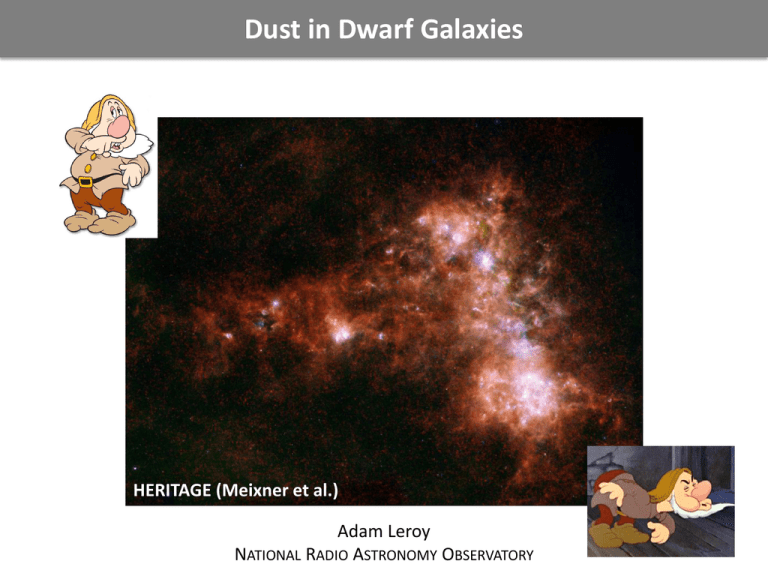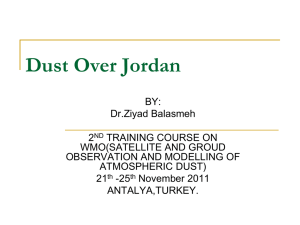Dust in Dwarf Galaxies
advertisement

Dust in Dwarf Galaxies HERITAGE (Meixner et al.) Adam Leroy NATIONAL RADIO ASTRONOMY OBSERVATORY Dust in Dwarf Galaxies HERITAGE (Meixner et al.) Adam Leroy NATIONAL RADIO ASTRONOMY OBSERVATORY Dust in Dwarf Galaxies SAGE (Meixner+ `06) Based on work by many of the folks here… Dust in Dwarf Galaxies is … D/G Less abundant than in spiral galaxies… … even more than you expect given the metallicity (?) SED The dust that is present is deficient in PAHs… … rich in small grains (and/or hotter) … … and exhibits a mysterious long-wavelength excess. ISM This dust is mixed with gas, making it an ISM tracer… … especially useful for hard-to-see molecular gas. SFR And dust appears to help regulate star formation… … influencing the balance of H2-and-HI. D/G How Much Dust in Dwarf Galaxies? DUST-TO-GAS RATIO Ratio of dust mass to total gas mass in the ISM. PNe, Old *s SN Accretion in clouds SNR Shocks Winds RELATION TO METALLICITY? Metallicity – ratio of heavy elements to gas mass. Significant fraction of heavy elements in dust in MW (Si, Mg, Fe; most C). Same in dwarfs? Expect roughly linear relation… Current Ensemble of Measurements D/G Dust-to-Gas Mass Ratio GALAMETZ, MADDEN, ET AL. ’11 : D/G in dwarf irregulars declines faster than metals … following LISENFELD & FERRARA `98, DRAINE+ `07, etc. … much more limited if only sub-mm observations used Linear Metallicity (12 + log O/H) Points: whole galaxies from wide-net literature trawl D/G Semi-Resolved: Dust-Poor Envelopes? Dust-to-Gas Mass Ratio DRAINE ET AL. ‘07: Aperture definition strongly affects D/G in SINGS dwarfs. Metallicity (12 + log O/H) Points: whole SINGS galaxies but dwarfs treated with varying aperture Dust-Poor Envelopes? D/G DRAINE ET AL. ‘07: Aperture definition strongly affects D/G in SINGS dwarfs. Only over IR Region Dust-to-Gas Mass Ratio DGR consistent with metallicity trend. Over the Whole Galaxy D/G lower than expected given a simple trend with metallicity Metallicity (12 + log O/H) Points: whole SINGS galaxies but dwarfs treated with varying aperture But it Does Break… Eventually D/G Dust-to-Gas Mass Ratio HERRERA-CAMUS ET AL. (2012): I Zw 18 upper limit rules out linear D/G vs. z Metallicity (12 + log O/H) Points: whole SINGS galaxies + I Zw 18 D/G But it Does Break… Eventually FISHER, BOLATTO ET AL. (IN PREP.): Herschel constrains I Zw 18 SED to be very hot low mass Points: SED of the very low-metallicity BCD I Zw 18 (courtesy D. Fisher) Dust in Dwarf Galaxies is … D/G Less abundant than in spiral galaxies… … even more than you expect given the metallicity (?) Dust Spectral Energy Distribution Emergent Energy (νFν) SED Wavelength (μm) Illustration: DustEM Model from Compiègne+ `11 Dust in Dwarf Galaxies SED PAH Emission Emergent Energy (νFν) Out of equilibrium emission from small, carbonaceous grains. Emission in bands from 1 to 20 μm. Large collecting area, minor mass fraction. Wavelength (μm) Illustration: DustEM Model from Compiègne+ `11 Dust Spectral Energy Distribution SED Small Grain Emission Emergent Energy (νFν) Emission from small dust grains out of equilibrium with the ISRF (stochastic heating). Contribute from 10 - 100 μm. Wavelength (μm) Illustration: DustEM Model from Compiègne+ `11 Dust Spectral Energy Distribution Emergent Energy (νFν) SED Large Grain Emission In equilibrium with the interstellar radiation field. Holds most dust mass, dominates above 100 μm. Wavelength (μm) Illustration: DustEM Model from Compiègne+ `11 PAH Features vs. Metallicity SED ENGELBRACHT+ `05, `08; MADDEN `06: PAH emission systematically declines with metallicity. Flux (Fν) [Jy] Metallicity Wavelength (μm) Spectra: IRS spectra of many galaxies binned and stacked by metallicity. PAH Emission vs. Metallicity SED Metallicity (12 + log O/H) ENGELBRACHT+ `05, `08: (Broadband) PAH strength drops around 12+log O/H = 8.2 8-to-24 μm Ratio (roughly tracing PAH strength) Each point: one galaxy SED Resolving Suppression of PAHs SANDSTROM+ `10: PAHs coincident with CO emission, shielding. 3σ CO Emission (well shielded) Map: Local PAH mass fraction (qPAH) in the Small Magellanic Cloud, Contour: NANTEN CO “Bluer” IR-Colors SED Emergent Energy (νFν) BERNARD+ `08: (M31) Milky Way LMC SMC progressively bluer far-IR color. Wavelength (μm) Spectra: SEDs of Milky Way, LMC, SMC SED “Bluer” IR Colors 70-to-160 μm Ratio (Temperature or VSG Contribution) ENGELBRACHT+ `05: 70/160 color correlates with metallicity. Temperature? Smaller grains? Metallicity (12 + log O/H) Points: Individual galaxies SED Long Wavelength Emission GALLIANO+ `03,`05, GALAMETZ `09: mm emission from dwarfs higher than expected for β=2. … Planck Collaboration `11 … these extend to longer wavelengths.in the SMC NGC 1569 Wavelength (μm) SMC Planck Collaboration `11 SED Long Wavelength Emission GALLIANO+ `03,`05, GALAMETZ `09: mm emission from dwarfs higher than expected for β=2. … Planck Collaboration `11 … these extend to longer wavelengths.in the SMC NGC 1569 Wavelength (μm) SMC Planck Collaboration `11 SED Long Wavelength Emission Excess Emission Above Standard Fit to SED in SPIRE 500 μm Band GALLIANO+ `11: Large Magellanic Cloud … sub-mm excess not correlated with H2 HI Surface Density H2 Surface Density Contours: Data distribution for excess measured line of sight by line of sight in the LMC Dust in Dwarf Galaxies is … SED The dust that is present is deficient in PAHs… … rich in small grains (and/or hotter) … … and exhibits a mysterious long-wavelength excess. ISM Dust as an ISM Tracer HERITAGE, SAGE, SAGE-SMC: Dust maps are ISM maps… Dust as an ISM Tracer ISM Milky Way Hydrogen Column Fit Optical Depth at 160 μm Sub-mm Emission at 550 GHz PLANCK COLLABORATION+ `11, LEROY+ `09: Correlation of dust emission, H in MW, SMC SMC HI Column Data: IR or sub-mm emission vs. gas column for individual lines of sight ISM Dust as an ISM Tracer • Dust traces the total (HI + H2) gas column • Estimate dust from IR emission, measure HI • Get gas-to-dust ratio by comparison with HI H2 = (dust × GDR)- HI ISM Dust as an ISM Tracer DAME+ `01: Works to match CO distribution in Milky Way Observed CO H2 from IRAS Dust Emission Comparison in Profile ISM Dust as an ISM Tracer LEROY+ `09: Reveals similar structure to CO mapping on small scales (10 pc) in SMC. CO emission H2 from Dust Maps: CO (left) and H2 estimated from IR emission (right) in the SMC star-forming complex N83/N84 ISM Dust as an ISM Tracer BOLATTO+ `11, LEROY+ `07: Combine IR imaging, HI to infer H2 distribution in the SMC IR Opacity (Spitzer) Atomic Gas (21-cm) Molecular Gas H2 = (dust × GDR)- HI Dust as an ISM Tracer ISM CO-to-H2 Conversion Factor LEROY+ `11: Conversion factor rises sharply at low metallicity. Dust a good alternative… Metallicity (12+log O/H) Points: Dust-driven solutions for the conversion factor in parts of Local Group galaxies Dust in Dwarf Galaxies is … ISM This dust is mixed with gas, making it an ISM tracer… … especially useful for hard-to-see molecular gas. SFR Dust as a Star Formation Regulator SCHRUBA+ `11: Correlation of star formation with molecular and atomic gas Atomic Gas (21-cm) Molecular Gas (CO 2-1) Points: Rings (azimuthal averages) in 30 disk galaxies SFR Dust as a Star Formation Regulator Molecular to Atomic Gas Ratio LEROY+HERACLES/KINGFISH (IN PREP.): Molecular to atomic ratio follows gas surface density. Points: kpc-resolution lines of sight in 22 disk galaxies SFR Dust as a Star Formation Regulator Molecular to Atomic Gas Ratio LEROY+HERACLES/KINGFISH (IN PREP.): Molecular to atomic ratio follows gas surface density. Points: kpc-resolution lines of sight in 22 disk galaxies Dust as a Star Formation Regulator SFR Molecular to Atomic Gas Ratio Divided by Avg. Ratio at that Surface Density LEROY+HERACLES/KINGFISH (IN PREP.): Molecular to atomic ratio follows gas surface density. Points: kpc-resolution lines of sight in 22 disk galaxies Dust as a Star Formation Regulator SFR Molecular to Atomic Gas Ratio Divided by Avg. Ratio at that Surface Density LEROY+HERACLES/KINGFISH (IN PREP.): Molecular to atomic ratio follows gas surface density. Points: kpc-resolution lines of sight in 22 disk galaxies Dust in Dwarf Galaxies is … SFR And dust appears to help regulate star formation… … influencing the balance of H2-and-HI. Dust in Dwarf Galaxies is … D/G Less abundant than in spiral galaxies… … even more than you expect given the metallicity (?) SED The dust that is present is deficient in PAHs… … rich in small grains (and/or hotter) … … and exhibits a mysterious long-wavelength excess. ISM This dust is mixed with gas, making it an ISM tracer… … especially useful for hard-to-see molecular gas. SFR And dust appears to help regulate star formation… … influencing the balance of H2-and-HI.




